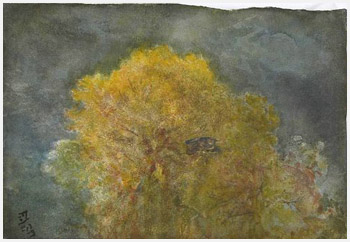BEGINNINGS
He was born in Calcutta, West Bengal. Born in an aristocratic
family, he was richly endowed with literary and artistic
talent. Abanindranath was among the first Indian artists
to address issues of culture specificity and modernism.
He began his career in the emergent years of Swadeshi
movement and was an apologist for nationalist revivalist
art. The fame of Abanindranath as the reviver of Indian
tradition and founder of a new movement, is in no way
less than that of Abanindranath, the artist. He made
a name in literature long before he established his
fame in art. He studied the canons of aesthetics and
had written on `Sadanga`. 1907 Established Indian Society
of Oriental Art, Calcutta. And he wrote books like Bharata-Silpa
Parichaya; Sakuntala (1895); Raj-Kahini (1905); Kshirer
Putul; Bhupatir Desh (1915); Nalaka (1916); Banglar
Brata (1919); Bageswari Lectures on Art (1919); Khajanchir
khata (1921); Budo Angla (1941) etc. He also wrote jatras
(folk drama)
|
EDUCATION
- Studied at Govt. School of Art and Craft, Calcutta.
- Private Tutors: Olinto Gilhardi & Charles Palmer.
- Pursuing his increasing interest in Japanese painting,
he learnt the Art of Japanese brushwork under Yokoyama
Taikan.
EXHIBITIONS
- 1900 Govt. School of Art and Craft Exhb., Calcutta.
American Federation of Art, USA.
- 1908 Inaugural Exhibition Indian Society of Oriental
Art, Calcutta (Also in 1910,12).
- 1911 Indian Society of Oriental Art, United Provinces
Exhibition Allahabad .
- Festival of Empire, organised by Indian Society
of Oriental Art, for George V`s Coronation, Crystal
Palace, England.
- 1914 22nd Exhb. of Societe des Peintres Orientalistes
Francois, Grand Palais, Paris, travelling to Belgium,
Holland and Imperial Institute, England.
- 1915-16 Indian Society of Oriental Art, Calcutta
and Young Mens Indian Association, Madras.
- 1924 Travelling Exhb. USA, organised by American
Federation of Art & Indian Society of Oriental
Art.
- 1928 Exhb. at Athenee Gallery, organised by James
Cousins, Geneva, Switzerland.
- 1996 An exhb. of Abanindranath`s work, Nandan Gallery,
Santiniketan.
- 2003 Manifestations, organised by Delhi Art Gallery,
World Trade Center, Mumbai and Delhi Art Gallery,
New Delhi.
COLLECTION
Her Majesty Queen Elizabeth II Collection, Windsor
Castle, England. Indian Museum, Kolkata. National Gallery
Modern Art, New Delhi. Oriental and India Office Library
and Records, London. Rabindra Bharati University Museum,
Kolkata. Victoria and Albert Museum, London. Lahore
Museum, Lahore. Bangalore Museum, Bangalore. P.N Tagore,
Kolkata. Mukul Ch. Dey, Kolkata. Sailendranath Dey,
Jaipur. O.C. Ganguli, Kolkata. Roopkrishna, Lahore.
Samarendranath Gupta, Lahore. Asit K. Haldar, Lucknow.
Vishnupada Roy Chowdhury, Howrah.
STYLE
In the paintings of Abanindranath we for the first
time discover an aesthetic quality rare in contemporary
works. He retained a realistic base and modified it
with selective assimilations of Mughal, Japanese and
Persian elements. Style is the chief attraction in Abanindranath`s
literary as well as pictorial compositions; the most
important point in them being, how he tells in the one
and how he shows in the other. He mainly used the wash
technique. Colours are flat with suggestion of space
finished with line.

back |



